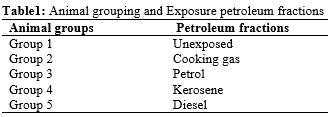Petroleum Fractions Induce Lipid Peroxidation, Histopathological and Haematological Changes in Wistar Albino Rats
DOI:
https://doi.org/10.54117/ijt.v2i1.2.2024Keywords:
Petroleum fractions, Wistar, histopathology, haematology, Lipid peroxidation, oxidative stressAbstract
Petroleum products pollution is one of the main cause of environmental toxicity. The study presents the effects of petroleum fractions intoxications with the underlying aim of quantifying the enzymatic activity, level of lipid peroxidation, histopathology and haematological changes in rats. Briefly, twenty-five (25) male rats weighing between 148- 172 g were divided into five groups of five animals each. Group 1, served as the control, Group 2 (rats exposed to cooking gas), Group 3 (exposed to petrol fraction), Group 4 (exposed to kerosene) and Group 5 (exposed to diesel fraction). Oxidative stress biomarkers, superoxide dismutase (SOD) and catalase (CAT) activities, malondialdehyde (MDA) and haematological parameters were quantified in the serum. Histological examination of the lungs was conducted to assess the impact of the inhalation. There was significant (p < 0.05) decrease in SOD activities (Grp1:105.20 ± 1.23, Grp2: 93.04 ± 0.92, Grp3: 88.60 ± 0.74, Grp4: 74.13 ± 0.59 and Grp5: 68.02 ± 0.25 µm/mins/mL) and CAT activities (Grp1: 5.70 ± 0.12, Grp2: 4.3 ± 0.12, Grp3: 3.60 ± 0.32, Grp4: 3.40 ± 0.04, and Grp5: 2.50 ± 0.02 µm/mins/mL) and concomitant rise in MDA levels MDA (Grp1: 88.50 ± 0.32, Grp2: 102.60 ± 0.42, Grp3: 121.30 ± 0.61, Grp4: 130.60 ± 0.72 and Grp5: 140.50 ± 0.95 moles of MDA/g tissues ×10-5). There was subsequent alteration in lung morphology of the lungs and haematological indices in serum. The findings imply that exposure to petroleum fractions by inhalation is a risk factor in the pathophysiology of pulmonary dysfunction and indication of oxidative stress.

